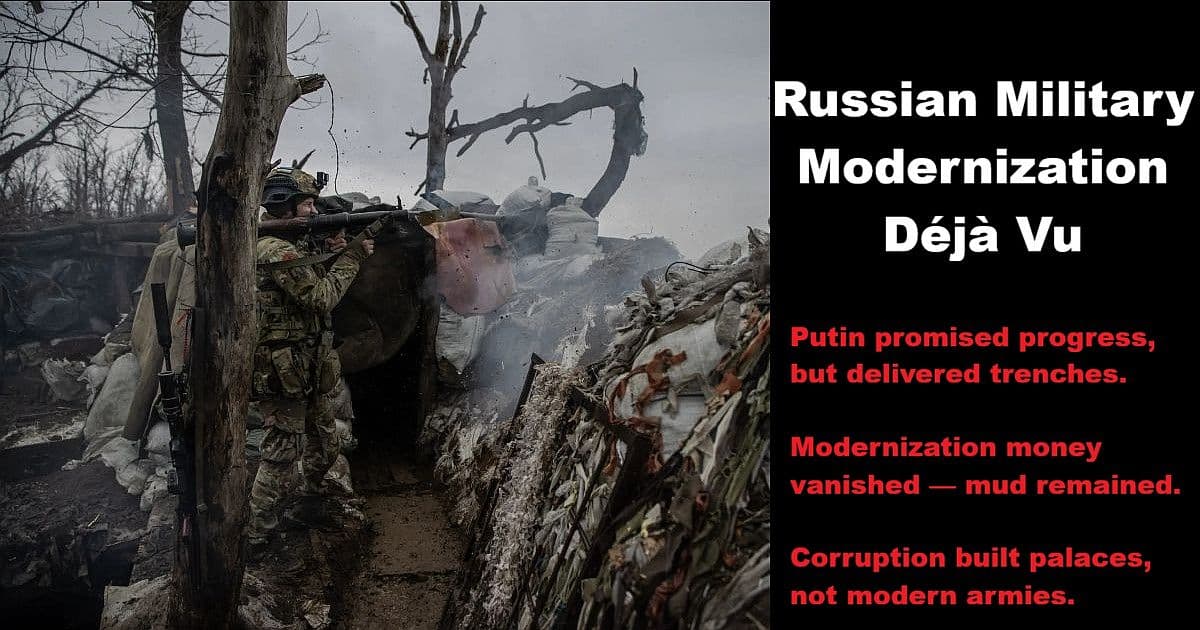
Bottom Line Up Front: Russian military modernization has been described as a “rebirth” more than once — in the 2000s, again before the 2022 Ukraine invasion, and now once more in 2025. Each cycle promises reform, new technology, and force generation, but the results often reveal the same weaknesses in logistics, corruption, and sustainability. The latest ISW update on Russian force generation and technological adaptations is only the newest chapter in a long-running pattern of déjà vu moments.
Russia’s First Modernization Drive (2000s–2010s)
After the collapse of the Soviet Union, the Russian military suffered a decade of neglect. By the early 2000s, Putin made Russian military modernization a national priority.
- Ambitions: streamline bloated Soviet structures, professionalize the army, replace outdated hardware, and build a modern defense industry.
- Achievements: some success in nuclear forces, missile systems, and elite units; limited capability shown in Chechnya and Georgia (2008).
- Problems: corruption siphoned resources, logistics lagged, and most forces still depended on aging Soviet equipment.
Déjà vu #1 – Ambitious modernization plans ran up against the same old inefficiencies and institutional resistance. See ECFR’s analysis on why reforms often fail.
The Pre-2022 Build-Up
By the late 2010s, Moscow once again claimed the military had been rebuilt. High-profile exercises like Zapad projected strength, while Russia’s Syria campaign (2015) suggested expeditionary capabilities.
- Narrative: Russia had learned from past wars and finally fielded a modern, capable army.
- Expectation: the Kremlin could now conduct a large-scale operation with confidence.
- Reality: the February 2022 Ukraine invasion revealed weak logistics, poor morale, and stiff resistance; supply convoys stalled and battlefield coordination collapsed.
Déjà vu #2 – A military that looked formidable on paper faltered in practice under real war conditions. Context: Galeotti on rebuild/destroy cycles.
Wartime Reconstitution (2022–2024)
When the blitz failed, Russia shifted to reconstitution. The goal: rebuild combat power while fighting.
- Manpower: partial mobilization, prisoner recruitment (e.g., via Wagner), and high cash incentives for volunteers.
- Equipment: Cold War tanks pulled from storage, refurbished, and sent forward; drones and shells sourced from partners.
- Industry: production lines increased output but leaned heavily on refurbishments, not truly new systems; precision munitions remained in short supply.
Déjà vu #3 – Russia again relied on quantity over quality. Reconstitution created numbers, but systemic flaws stayed untouched. Note the 2024 claim of near-reconstitution: DefenseNews.
On September 24, 2025 – ISW Russian Force Generation Update
The Institute for the Study of War (ISW) released its Russian Force Generation and Technological Adaptations Update, highlighting Moscow’s latest efforts to adapt amid the ongoing Ukraine conflict.
While Russia showcases tactical adjustments, the same structural flaws — corruption, logistical bottlenecks, and reliance on outdated systems — persist, echoing past modernization cycles.
- Technology: Russia has deployed advanced counter-drone systems, such as the Krasukha-4 electronic warfare platform, to disrupt Ukrainian UAVs, alongside rapid field modifications like “cope cages” on tanks to counter Javelin missiles. However, these adaptations are often reactive, addressing Ukrainian tactics after heavy losses.
- Production: Munitions output has increased incrementally, with factories like Uralvagonzavod refurbishing T-62 and T-72 tanks from Cold War stockpiles. New production remains limited, and reliance on foreign supplies (e.g., North Korean artillery shells) underscores industrial weaknesses.
- Force Generation: Recruitment continues through high financial incentives and coerced contracts, but training remains inconsistent. Reports indicate recruits often receive only weeks of preparation before deployment, leading to poor coordination and high casualty rates in Donbas offensives.
Déjà vu #4 – The 2025 adaptations mirror the 2008 Georgia campaign, where Russia showcased new tech and tactics but was hamstrung by logistical failures and poorly trained forces. As in 2022, corruption diverts funds from training and maintenance, and the dependence on refurbished Soviet-era equipment limits battlefield effectiveness. The ISW notes that while Russia can sustain its war effort, it cannot achieve the transformative modernization it claims. (Source: ISW)
Why Russian Military Modernization Keeps Repeating
The déjà vu factor is no accident. Russia’s modernization story has recycled for decades because the root causes never change.
- Corruption siphons funds — contracts inflated, maintenance neglected.
- Leadership prizes appearances — parades and exercises over structural fixes.
- Dependence on legacy systems — old tanks and aircraft endlessly refurbished.
- Misjudgment of adversaries — from Georgia to Ukraine, Russia consistently underestimates resistance.
For background on the persistence of these limits, see the Atlantic Council report.
Outro
The story of Russian military modernization since 2000 is a loop: reform, rearmament, failure, rebuild — then repeat. The 2025 ISW update is not evidence of transformation but another déjà vu moment.
Until Moscow tackles corruption, logistics, training, and strategic culture, every so-called “rebirth” of the Russian military will end the same way: impressive headlines, disappointing performance, and another déjà vu in the making.
And let’s not forget the politics. President Trump only recently admitted that Ukraine can win — a sharp reversal from years of downplaying Kyiv’s chances. Trump now says Ukraine can reclaim all territory lost to Russia, marking a policy shift after prior ambiguity. His flip-flop highlights a deeper failure: Russia’s military weaknesses were exposed in 2022 when Putin’s invasion stalled, yet Trump refused to acknowledge the reality. The MAGA movement, too, has long echoed Trump’s earlier stance — portraying Russia as strong and Ukraine as doomed — and many voices have not followed his reversal. Just as Moscow repeats broken modernization cycles, Trump and his movement repeat the habit of clinging to false narratives until the truth becomes undeniable.
